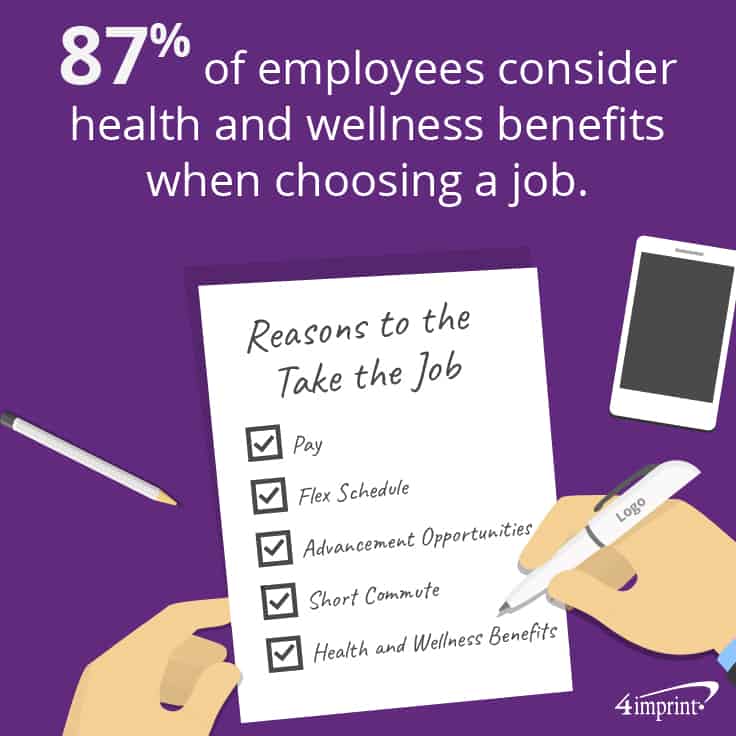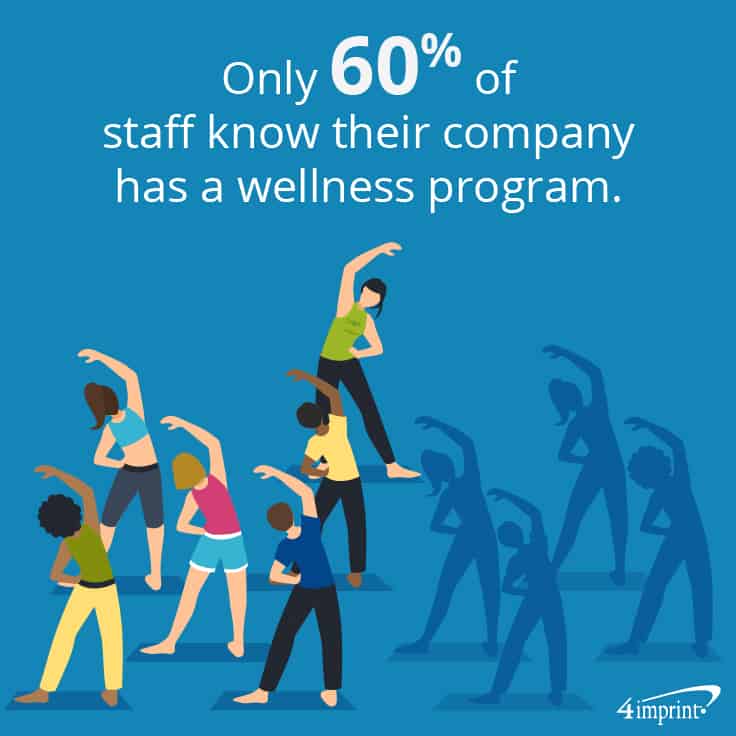Workplace wellness is on the rise, with 80% of businesses offering programs ranging from health fairs to exercise classes to healthy giveaways. However, while many businesses want to help their employees take better care of themselves, they sometimes struggle with employee participation.
In this edition of our Blue Papers® we talk about the benefits of a strong wellness program, the barriers to participation, and how to encourage employees to take the first step in getting healthier.
Benefits of wellness programs
In many ways, employee wellness programs also make companies healthier. Creating and maintaining strong health and wellness initiatives offers benefits for both your staff and your business.
It can help employees manage stress
Workplace stress has risen 20% over the last 30 years, with nearly 60% of Americans saying that work is a significant source of stress. Implementing healthy practices, like mindfulness or yoga, as part of a wellness program can help reduce employee anxiety, depression and stress.
It improves recruiting and retention
Wellness programs also offer benefits that can affect your bottom line. About 87% of employees consider health and wellness benefits when deciding whether to take a job. And only 25% of employees at a company with a health and wellness program say they intend to leave their job in the next year—vs. 51% of employees at companies without wellness programs.

It has a great ROI for employees
For every dollar you invest in employee wellness, employees recoup between $1.40 and $4.60 in medical costs and productivity losses.

It has a great ROI for your business
When your employees use wellness programs to make important lifestyle changes, you’ll recoup more than $350 in productivity for every employee (according to the Snack Nation article linked above). Employees are also less likely to miss work, more engaged with their workplace, and 67% more satisfied with their jobs than those who work at a company without an employee wellness program.
Breaking down wellness walls
Though the benefits of wellness programs are obvious, getting employees to participate in them can be a challenge. Reasons employees say they don’t participate include:
- Lack of time: 63% of employees say they aren’t willing to devote more than an hour per day to improve their health and well-being.
- Lack of interest: If employees don’t know that a wellness program exists, they wouldn’t know which parts might interest them. Or if they feel the incentives to participate aren’t worth the time, they may choose to avoid the wellness program altogether.
Also, if your company doesn’t dedicate resources to provide a variety of wellness initiatives, employees may become bored or may not be interested at all. Forming a walking group during lunch is a no-cost option, but funding speakers or educational materials would take your program to the next level.
Breaking down the walls to wellness
With so many potential benefits, helping employees break down (or climb over) their walls to wellness will make your workplace healthier and happier. Here are some ways to help staff walk the wellness path.
Spread awareness
Only 60% of employees are aware that their company has a wellness program. Simply making everyone aware of the program and the pieces of it that may interest them—whether it’s free flu shots or an indoor walking group—may be all it takes to get them to take their first steps. Consider:
- Sharing updates, incentives and wellness challenges through a monthly newsletter.
- Setting up a wellness portal that lets employees track their progress.
- Bringing in guest speakers to offer wellness tips or explain the benefits of your wellness program.

GOAL High School in Pueblo, Colorado, goes out of its way to get staff involved in their wellness program—and gives them frequent updates about benefits of the program. “We decided that in order for our students to thrive in their blended online educational environment, we needed to make sure our staff was healthy,” said Enrollment & Wellness Coordinator Shannon Lovato. “We send out information about the health benefits that our insurance provides that they might not be aware of. Things like lunch and learns and other content they can use.”
Implement the program gradually
Presented with a long checklist of wellness items, some people will become overwhelmed and elect not to do anything at all. Consider ramping up your program over months or years to get all the pieces in place.
GOAL High School takes a “rounded” approach to wellness, using the 8 dimensions of wellness to create a wellness wheel:
- Emotional
- Environmental
- Financial
- Intellectual
- Occupational
- Physical
- Social
- Spiritual
“You really want to get that wheel to roll,” Lovato said. “What do you do well? Eat well, get to the gym every day? Are you struggling on the financial side?”
To keep the wheel moving, they focus on a different dimension of wellness each month. “This month, for example, we focused on occupational wellness,” Lovato said. “What is it? What things can you do to increase it? Do you have a tidy desk? Are you really in a job that makes you thrive?”
To get people thinking about the dimensions, they start the school year off with wellness program giveaways that represent each aspect of wellness. “We gave out portion control containers, financial planning sheets, a massage tool and other items to make sure people are thinking about all kinds of wellness,” Lovato said.
Approaching the different aspects of wellness this way helps people work on every dimension without having to address all of them at once.
Provide time for wellness
Because employees frequently struggle to find time to devote to wellness outside of work, consider offering them opportunities to get healthy during their workday:
- Allow employees time for a 30-minute walk or use your company gym.
- Provide healthy snacks like fruits and nuts to help them eat better.
- Turn conference room meetings into walking meetings.
- Start each day with a five-minute meditation.
Find ways to make wellness more fun
Getting healthier can feel like a chore. Find ways to encourage competition or just make the process more enjoyable.
- Get employees together for a weight loss challenge.
- See who can walk the most steps in a day, week or month.
- Create a healthy recipe exchange group.
- Compete to see who can create (and eat) the healthiest lunch.
Offer small health giveaways as prizes for the winners—or even just for competing.
ChromaScape in Twinsburg, Ohio, used basketball season to create a “March Wellness” challenge using a Basketball Stress Reliever and a themed wellness contest.
“All our associates got a ball, and it helped to create buzz around the office,” said Employment and Benefits Manager Amanda Hatfield. “Plus, it was a fun way to reduce stress in meetings. We make a bracket, with the goal to pick one habit and stick to it for five weeks.”
In the first “bracket” everyone chose an activity, from bringing a healthy lunch from home to exercising for 30 minutes a day. Participants who made it through the challenge were entered into a gift card raffle.
The reminders, wellness program giveaways and incentives from the challenge led to long-term benefits as well. “We definitely had some success stories,” Hatfield said. “People who lost weight and kept it off, people who continue to lose weight, even people who are still making sure they’re drinking enough water in a day.”
Set personalized attainable goals
Whether it’s walking three nights a week or quitting smoking, let employees choose which wellness goals they want to work on and then monitor it to help them be more successful.
Choose employee leaders
Having employees encourage other staff members to get involved in wellness challenges and take part in the program can be a powerful motivator to encourage participation.
GOAL High School uses MicroSoft Teams® to let staff share their wellness interests. “When you get the staff to invest and get them to lead and get them to run with it, you’re able to get staff more involved,” Lovato said. “We have a channel for all dimensions of wellness. There’s one for crafty people, for example, and if you ‘like’ the channel, you can follow it.”
Incorporate wearables
Offering employees a step tracker can be a simple and creative method to encourage people to improve their wellness. Even if the healthy giveaway encourages employees to take just a few more steps per day, over time those steps add up.
“We buy Fitbits® for every staff member who wants one,” Lovato said. “The tagline for GOAL is ‘Change Your World,’ so we have a walking program called ‘Walk Your World’ to see how many steps the staff takes, to see how many times we can walk around the world.”
Spread out incentives over time
Offering a single incentive for achieving a goal is helpful, but not as helpful as offering a variety of incentives over time. By encouraging employees to keep building a habit, you’ll help them make healthy choices that turn into life changes. A single incentive encourages them to do something for a few weeks in order to win a prize.
Walking the road to wellness
Healthy giveaways and employee wellness programs offer major benefits to both employee and company health. Every time you encourage an employee to eat better, take a walk or try meditation, you’re investing in their well-being—and yours.

